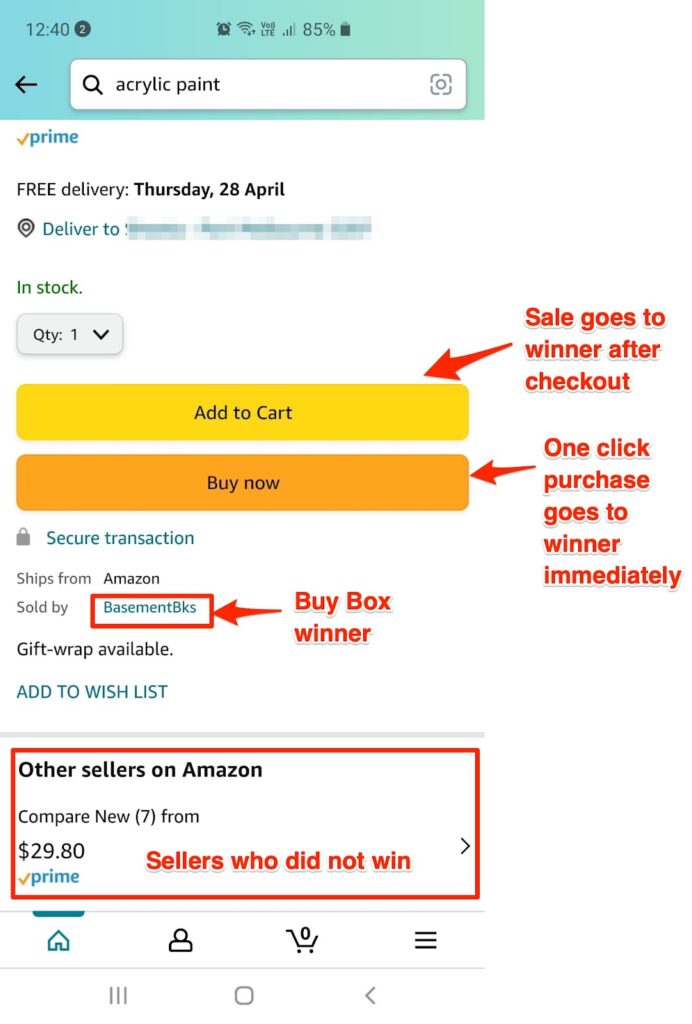Among Amazon’s more than 6 million third-party sellers, the second largest business model is wholesale selling. With over a quarter of sellers adopting wholesale strategies to make up some, or all, of their sales, the model has proven to be incredibly profitable and successful. This raises the question, what makes Amazon wholesale profitable for sellers?
What is Amazon Wholesale?
Amazon sellers adopting a wholesale strategy purchase products from established brands in bulk to resell to consumers. While many types of products and different brands can be bought and sold wholesale, the key is to find high-demand products that are highly sought after.
Steps to Selling as an Amazon Wholesaler
Once you’ve done your research and decided on a product to sell, you’ll need to reach out directly to the brand, manufacturer, or distributor to develop a relationship. Unlike business to consumer (B2C) sales models, wholesale has a business to business (B2B) angle– meaning that it’s important that you can provide value to the brand as much as you provide value to the consumer purchasing from you. By developing a relationship over time you can demonstrate how you, as an Amazon seller, bring unique advantages to the brand, and can improve sales to benefit everyone. After obtaining inventory you can list the product for sale on Amazon and begin the process of winning the Buy Box to grow your business.
What makes Amazon Wholesale unique?
While wholesale has many similarities to other selling strategies used by Amazon sellers, there are some significant differences.
Wholesale vs. Arbitrage
Both wholesalers and arbitrage sellers operate by purchasing and reselling branded products on Amazon. This means that in many cases wholesalers and arbitrage sellers can end up competing against one another for the coveted Buy Box of a product listing. However, distinctions between the models ultimately creates two unique sets of business strategies.
Arbitrage sellers source inventory from retail or online stores, while wholesalers work directly with brands and distributors to order their inventory. By cutting out the middleman and obtaining products earlier in the supply chain, wholesalers are able to place bulk orders and ensure greater inventory, thus avoiding stockouts. This also allows wholesaler sellers to negotiate better prices, whereas arbitrage sellers are constantly on the lookout for discounted items that they can markup when reselling on Amazon.
Wholesale vs. Private Label
In contrast to wholesalers, private label sellers create their own branded products to sell on Amazon. As a result, private label sellers are required to create unique product listings, while wholesalers often can add their offer to an existing listing.
While wholesalers often compete with other sellers for the Buy Box, private label sellers have different but competing product listings. This often requires private label sellers to invest in advertising and PPC campaigns in order to be successful, while wholesalers can leverage existing product marketing and demand.
Wholesale vs. Drop Shipping
Similarly to Amazon wholesalers, dropshippers source products directly from a brand, manufacturer, or distributor–often requiring a long term relationship to do so. Since Amazon sellers who use drop shipping strategies often share product listings with wholesalers and arbitrage sellers, they can end up competing with one another for the Buy Box.
Unlike wholesalers though, Amazon sellers who drop ship purchase inventory one item at a time. Instead of keeping enough inventory to meet demand, drop shippers wait till customers make a purchase and then purchase the number of items to fulfill the order, ensuring that they never have money tied up in unsold stock.
What makes Amazon Wholesale profitable?
Since Amazon wholesalers are often vying for the elusive Buy Box, it’s critical that you offer competitive prices. This means that although you’re purchasing inventory in bulk and at lower prices, you’re still likely going to have low profit margins. This raises the question if it’s not the profit margins, what makes wholesale profitable for Amazon sellers?
The answer is that what makes Amazon wholesale profitable is that it’s a quantity over quality game. Since wholesale items are typically already in high demand you’ll be doing large volumes of sales that add up quickly. On top of that you’ll likely be working with well established brands that already have marketing– meaning that there are significantly less options there, so very little investment required for success other than ensuring you have enough inventory to meet demand.
Winning the Buy Box

When a product listing has multiple sellers, like in the case of many wholesale items, Amazon sellers compete to win the Buy Box and become the default seller. Although customers can manually select any seller’s offer, the winner of the Buy Box inevitably generates the most sales– which is one of the easiest ways to make Amazon wholesale profitable. Even if your profit margins are slim from competitive pricing, if you have constant control over the Buy Box the sheer volume of your sales will more than make up for it.
Since Amazon uses several factors to determine the winner of the Buy Box, there’s no way to guarantee success. However, by paying attention to these factors you can ensure that you have a strong chance of winning and making your Amazon wholesale business even more profitable:
Fast Shipping & Prime Eligibility
With the advent of Amazon Prime customers have become expectant of fast deliveries for eCommerce. In keeping with that, sellers who can guarantee quick shipping are far more likely to win the Buy Box.
This encourages many Amazon wholesalers to utilize Fulfillment by Amazon (FBA) services which includes the promise of 0 to 2 day shipping and Prime eligibility for products. While Prime eligibility is not required to compete for the Buy Box, it does help boost your chances of winning as Prime products are given priority.
Competitive Pricing
Amazon wants to offer its customers the best possible deal in order to generate more sales and repeat customers, meaning that the more competitively your product is priced the better chance you have at winning the Buy Box.
While undercutting competing Amazon sellers is important to winning the Buy Box, be sure to comply with the minimum advertised pricing set by the brands that you’re working with. Wholesale sellers who don’t respect the guidelines set out by brands and manufacturers risk losing that relationship and their ability to source products with it.
Stock Availability
By keeping enough inventory in stock to meet demand you show Amazon that you’re prepared for customers. This gives Amazon wholesalers a particular advantage when it comes to winning the Buy Box since bulk orders ensure you have inventory readily available.
Seller Metrics
Amazon gives priority to sellers that they trust– meaning that you need to ensure your seller rating is in tiptop shape. Seller ratings are influenced by a number of factors including order cancellations, customer feedback, and percentage of defective products. Your response times to customer queries and problems also play a role in your ability to win the Amazon Buy Box, along with seller experience.
Potential for Exclusivity
Once you’ve been operating your Amazon wholesale business for a while, there is the potential to gain exclusivity deals for specific brands or products. While exclusivity is typically reserved for larger sellers, maintaining a healthy and mutually beneficial relationship with your wholesale suppliers can open doors to achieve this and help make your Amazon wholesale business profitable.
Brands struggle with having too many resellers that oversaturate the marketplace, so if you can obtain any level of exclusivity for a coveted brand or product you can corner the market. Amazon wholesale sellers who have an exclusive brand or product have the potential to generate greater sales and profits, all while facing less competition.
Cash Flow through Funding to Scale
The best sellers understand that one of the best ways to improve your Amazon wholesale business profitability is to continue scaling your business.
Just like any other business, your Amazon wholesale business is limited by its cash flow. You can’t buy more inventory than you have capital available, and as a result you can’t ever make more than what you sell. Luckily, part of what makes Amazon wholesale so profitable is the fact that your products are already in high demand– which means that more inventory is almost guaranteed sales.
Taking on a sustainable amount of funding can greatly improve your buying power and streamline your cash flow, ensuring that you can buy enough inventory to keep up with demands. This also means that you’ll be able to scale rapidly since improved cash flow means improved profits in the long run. By finding and working with an eCommerce funding provider that understands your wholesaler cash flow conversion cycle, you should be able to boost cash flow and guarantee growth.
Challenges to Making Amazon Wholesale Profitable
While Amazon wholesale can be incredibly lucrative and successful for many Amazon sellers that doesn’t mean it’s without obstacles. In order to make Amazon wholesale profitable and scalable for sellers, they need to think strategically about inventory, cash flow, and more. Overcoming these challenges will help ensure that your Amazon wholesale business can grow sustainably.
Limited Buying Power & Upfront Cost
One of the downsides of selling on a wholesale model is the steep upfront cost for inventory. While Amazon wholesalers typically focus on products and brands that already have high demand, and therefore sell quickly, sellers still have to wait for payouts from Amazon. The delay between making sales and receiving your payout can be anywhere from the next day to a week, but if you sell out of your inventory in that time your sales will halt altogether.
This struggle with limited buying power is what stunts the growth of many Amazon sellers’ wholesale businesses. To mitigate these challenges and improve your cash flow, consider taking on a sustainable amount of funding that will help you purchase inventory more frequently– ensuring that you never lose another day of sales.
Competition
As mentioned above, wholesalers can face lots of competition for products that they don’t have exclusivity deals for. Not only are they competing for the Buy Box with other Amazon wholesalers, but also arbitrage and dropshipping sellers.
In order to stay ahead of competitors, it’s crucial that Amazon sellers using the wholesale model develop and maintain strong relationships with their suppliers. With strong interpersonal relationships you can negotiate better prices for inventory, work towards exclusivity, and more.
Scalability and Strategy Makes Amazon Wholesale Profitable
Thanks to ease of execution and the ability to scale rapidly Amazon wholesale is incredibly profitable for sellers. With working capital specifically designed for wholesalers at your disposal through Viably, making your Amazon wholesale business profitable is as simple as upgrading buying power to increase inventory and generate more sales. By taking advantage of smart strategies, like improving your ability to win the Buy Box, Amazon wholesalers can all but guarantee success.

